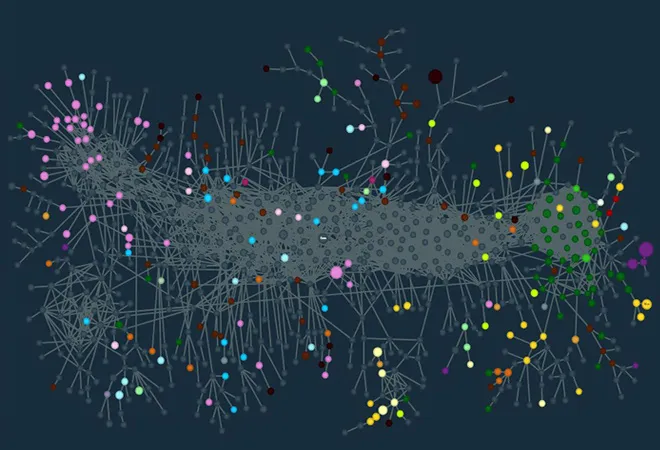
The product space is a visualisation of a country’s exports, grounded in network science and economic theory. See India’s product space below. Each node in the product space is a class of similar products. The coloured nodes on a country’s product space are classes of products for which a country has a revealed comparative advantage (RCA). <1> In India, this is primarily in garments (dark green) and chemicals (pink). The size of each node represents the share of the product in the country’s total exports. The product space illustrates probabilities of co-exporting classes of products. <2> The closer two nodes are to each other, the greater the probability that a country exporting one will export the other. Intuitively, the product space maps knowhow and capabilities inherent in a country at a given time. The evolution of international trade suggests countries’ product spaces evolve in a predictable manner — jumping from one class to close and similar class of products. The product space can therefore be used to identify pathways for export diversification and increased sophistication. India should strategically map pathways for diversification using the product space technology and upgrade capabilities at the frontier of its product space.
Consider this simplified example. If a country exports apples, it will likely also be able to also produce pears because of the closeness of the know-how, technologies, and capital required for either product. <3> In contrast, an apple exporting country might have difficulties acquiring competitive advantage in exporting medical devices, as the capabilities required for one are vastly dissimilar to those of the other. By carefully studying the product space we can make informed decisions about how best to make bets on evolving industries by building upon what India is already good at. India’s industrial policy should thus coordinate across sectors as well as skills to ready the country for this structural transformation.
The product space illustrates probabilities of co-exporting classes of products. The closer two nodes are to each other, the greater the probability that a country exporting one will export the other.
India’s companies form a crucial component of this industrialisation strategy. Consider the story of how South Korea’s LG Corporation came to be the behemoth that it is today. At its founding in the 1940s, LG was making cosmetic creams, today LG is a major household multinational with capabilities in high-end electronics. <4> How did LG make these jumps? According to Cha-Kyung Koo, LG Honorary Chairman, at the time of LG’s founding, then a cosmetic cream company it needed a steady supply of cream jars and plastic caps, key complements to cosmetic creams. There were few makers of these adjacent products so LG ventured into the plastics business. Plastic caps alone were not sufficient to run the plastic molding plant, so LG added combs, toothbrushes, and soap boxes to reap economies of scale. This plastics business also led LG to manufacture electric fan blades and telephone cases, which in turn led the company to manufacture electrical and electronic products and telecommunications equipment. The plastics business also took LG into oil refining, which needed a tanker shipping company. The oil refining company alone was paying an insurance premium amounting to more than half the total revenue of the largest insurance company in Korea. Thus, an insurance company was started. This natural step-by-step evolution through related business resulted in the Lucky-Goldstar (LG) group as we see know it today. <5>
As diversified conglomerates so it is with individual countries. Korea made jumps in its product space to develop higher quality and more sophisticated exports. <6> The product space in addition to revealing opportunities for diversification, illuminates opportunities for leveraging existing capabilities for producing higher value products. The quality, complexity and sophistication of a country’s exports is an important determinant of growth. Scholars at Harvard and MIT have shown that countries with high initial levels of economic complexity, an indicator of deep product space, tend to grow faster than less complexity countries with sparse product spaces. <7>
In the Indian context, the value of products can be defined along the lines of different policy priorities. For instance, value can be ascribed to a product or industries based on financial value add, social values, or strategic value such as employment. <8> India is experiencing a demographic shift, resulting in a growing working age population, at the same time that it is experiencing stagnation in manufacturing employment, a shift of workers out of agriculture and rapid advancements in automation, AI and machine learning—making job creation and employment an imperative. With this in mind, high-value products can be defined as those that are higher productivity goods, as well as those in labour intensive industries.
By carefully studying the product space we can make informed decisions about how best to make bets on evolving industries by building upon what India is already good at. India’s industrial policy should thus coordinate across sectors as well as skills to ready the country for this structural transformation.
What has been less explored is how the product space can be exploited to strategically identify skilling and capability enhancement opportunities. India has experienced a recent pivot towards human capital development as a driver of growth and employment. It has been recognised that the skills and capabilities of individuals must be enhanced to both increase individual and firm productivity, as well as to meet the changing demand of industry due to technological adoption and digitisation. What is less evident however, is how skilling, upskilling and reskilling initiatives are identified and prioritised. The product space should be leveraged in 3 ways for developing a strategic approach to this end.
First, the product space of a country reveals what the country’s future growth trajectory will likely look like, allowing pre-emptive skilling measures in strategic industries.
Second, with the definition and identification of strategic and high value industries, the product space can be used to identify pathways for expanding into these industries based on existing capabilities in the economy.
Third, countries that have know-how in the center of the product space, which is made up primarily of machinery, metal products, chemicals and capital intensive goods, have capabilities that are applicable to a larger number of other products than those at the periphery. <9> Products at the center — and denser part of the of the map also tend to be more sophisticated than those at the periphery. A shift in focus towards enhancing relevant skills in these areas would mean enhanced sophistication, and a larger body of skills that are deployable in a larger number of other industries.
The product space offers an opportunity to look strategically at India’s export basket, and identify feasible paths towards diversification, increasing the quality and sophistication of exports, increased complexity, <10> and strategic areas for skilling and human capital development investments. Coordinated industrial policy is needed across India’s leading sectors as well as agencies related to human resource development to ensure the country effectively leverages this technology.
<1> The OEC uses Balassa’s definition of RCV.
<2> As defined by HS or SITC classifications.
<3> https://growthlab.cid.harvard.edu/about
<4> http://www.lgcorp.com/about/history.dev
<5> Source: http://cid.kdi.re.kr/upload/20120808_1.pdf
<6> Rahul Anand, Kalpana Kochhar, and Saurabh Mishra, “Make in India: Which Exports Can Drive the Next Wave of Growth,” International Monetary Fund Working Paper WP/15/119 (2015) p.4.
<7> https://growthlab.cid.harvard.edu/
<8> Rajat Kathuria, Mansi Kedia and Uttara Balakrishnan, “Mapping the Future of High Value Manufacturing in India,” ICRIER Working Paper 285. (2014) p. 6.
<9> Rajat Kathuria, Mansi Kedia and Uttara Balakrishnan, “Mapping the Future of High Value Manufacturing in India,” ICRIER Working Paper 285. (2014) p. 6.
<10> Cesar Hidalgo, Albert-Laszlo Barbasi, Bailey Klinger and Ricardo Hausmann, “The Product Space and its Consequences for Economic Growth,” Science 317, 482 (2007).
The views expressed above belong to the author(s). ORF research and analyses now available on Telegram! Click here to access our curated content — blogs, longforms and interviews.




 PREV
PREV


